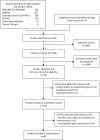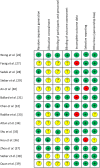Is the bispectral index monitoring protective against postoperative cognitive decline? A systematic review with meta-analysis
- PMID: 32053678
- PMCID: PMC7018011
- DOI: 10.1371/journal.pone.0229018
Is the bispectral index monitoring protective against postoperative cognitive decline? A systematic review with meta-analysis
Abstract
Background: Several studies have suggested that monitoring the depth of anaesthesia might prevent the development of postoperative cognitive decline. We aimed to conduct a meta-analysis to investigate the effects of bispectral index (BIS) monitoring in anaesthesia.
Methods: We searched in six major electronic databases. Trials were included if they discussed anaesthesia with and without BIS monitoring or low (<50) and high (≥50) BIS levels and which measured the risk of postoperative delirium (POD) and/or postoperative cognitive dysfunction (POCD).
Results: We included fourteen studies in the systematic review, eight of which were eligible for meta-analysis. BIS proved to be protective against POD at 1 day postoperatively in a cohort of 2138 patients (16.1% vs. 22.8% for BIS vs. no BIS groups, respectively; relative risk [RR] 0.71; 95% confidence interval [CI] 0.59 to 0.85, without significant between-study heterogeneity I2 = 0.0%, P = 0.590). The use of BIS was neutral for POCD at 1 week but protective for POCD at 12 weeks (15.8% vs. 18.8% for BIS vs. no BIS groups, respectively; RR = 0.84, CI: 0.66 to 1.08), without significant between-study heterogeneity (I2 = 25.8%, P = 0.260). The neutral association at 1 week proved to be underpowered with trial sequential analysis. In the comparison of low BIS versus high BIS, the incidence of POD at 1 day was similar in the groups.
Conclusion: Our findings suggest a protective effect of BIS compared to not using BIS regarding the incidence of POD at 1 day and POCD at 12 weeks. However, limitations of the evidence warrant further investigation to identify those groups of patients by age, comorbid conditions and other individual variables who would benefit the most from the use of BIS monitoring.
Conflict of interest statement
The authors have declared that no competing interests exist.
Figures







References
-
- Moller JT, Cluitmans P, Rasmussen LS, Houx P, Rasmussen H, Canet J, et al. Long-term postoperative cognitive dysfunction in the elderly ISPOCD1 study. ISPOCD investigators. International Study of Post-Operative Cognitive Dysfunction. Lancet. 1998;351: 857–861. - PubMed
-
- Funder KS, Steinmetz J, Rasmussen LS. Cognitive dysfunction after cardiovascular surgery. Minerva Anestesiol. 2009;75: 329–332. - PubMed
Publication types
MeSH terms
LinkOut - more resources
Full Text Sources
Medical
Miscellaneous

